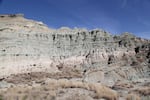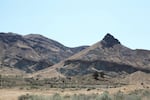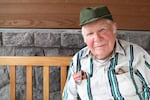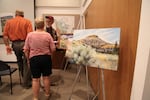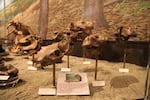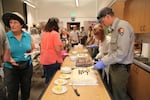Just six miles from the ever-popular Painted Hills in Central Oregon, the John Day Fossil Beds remain a best-kept secret of Oregon. This weekend the park staff, along with the public, celebrated numerous milestones of the area that are recognized as an international treasure.
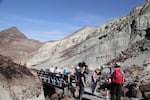
Dozens of people came to the John Day Fossil Beds Saturday to celebrate three anniversaries, including its discovery 150 years ago, its establishment as a national monument 40 years ago, and its visitors center, which was built 10 years ago.
Lizzy Duffy / OPB
This year marks 150 years since the park's discovery by Thomas Condon, 40 years since the area was named a national monument and 10 years since the National Park Service opened the Thomas Condon Visitor Center near Sheep Rock.
Dozens of of people came to the fossil beds to mix with current and former employees of the monument, learn more about the area's history and enjoy slices of celebratory cake.
Among the park's alum is Daron Dierks who was one of the first two hires after the state park became a national monument under superintendent Ben Ladd in 1975.
"We did all sorts of things," Dierks said. "We built park infrastructure here."
Before the the fossil beds were protected by NPS, visitors would take artifacts from the site and people were allowed to hunt, which he said took a while to change their attitudes.
With the staff so small, Dierks also took on odd jobs around the site. He built the first signs for Turtle Cove and the Painted Hills in his own garage. Dierks was also in charge of cleaning the bathrooms at the end of the day, which is where he met many people passing through, who were curious about the park.
"I had the toilet brush in my hand, so I'd used the toilet brush as a pointer," he said. "So I called this the toilet brush lectures. I gave a lot of those. These people were interested in fossils, and they were interested in the fact that the parks service were working on a fossil park. And they were willing to drive way out of their way to come."
When looking around the fossil beds, visitors may wonder what work is really being done with no dig sites around. Museum curator and chief of paleontology Josh Samuels said the staff is dedicated to preserving fossils that are uncovered due to natural erosion. By closely monitoring the various sites throughout the monument, Samuels said scientists will go into the field to collect fossils one to two times per week.
"I have never come back empty handed," said Samuels, who has been working at the fossil beds for more than five years.
The unique layering of ash and lava flows at the John Day Fossil Beds has made it possible for paleontologists to record the evolution of plants and animals that are between 5 million and 50 million years old. In particular, scientists have been able to closely trace the ancestry of horses and dogs at the John Day Fossil Beds. Samuels said other U.S. fossil sites don't have similar build up of history, making it difficult to date the discoveries.
People stream through the park by the thousands each year, but Samuels said the world-class fossil bed may still come to a surprise to many Oregonians.
"A lot of people in Oregon don't realize that this park is in their own backyard, and really don't realize the significance of it and the long history of it," he said.
OPB previously reported on the significance of the John Day Fossil Beds National Monument in 1994. Check out the video:

